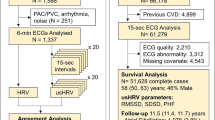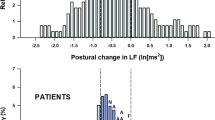Abstract
The heart rate variability (HRV) is the difference between consecutive R-R intervals of heartbeats measured in milliseconds. HRV indices represent the role of sympathetic and parasympathetic autonomic branches. Even though HRV is considered an indirect biomarker of Autonomic Nervous System, there are not yet standardized protocols providing reliable clinical measures. One of the reasons is because HRV techniques requires long recording periods. There are attempts of decreasing the required recording, such as the strategy of ultra-short HVR recording (<one minute), which could make the utilization of the technique easier. However, there is little published about its reliability. This work proposes a method to evaluate the reliability of ultra-short HVR based in Poincare map and Recurrence Quantification Analysis, well known methods to assess nonlinear and dynamic information from a system, in order to verify the reliability of the use of ultra-short term HRV. Then, these results was compared with the classical HRV coefficients, such as rMSSD, recorded from subjects in spontaneous breathing and also, in controlled breathing protocols. As a conclusion, using the proposed methods, we were able to show the discrepancy between the segments of interest, both on mean and in variance, explained in the analysis of main components.
Access this chapter
Tax calculation will be finalised at checkout
Purchases are for personal use only
Similar content being viewed by others
References
Task Force of the European Society of Cardiology and the North American Society of Pacing and Electrophysiology (1996) Heart rate variability: Standards of measurement, physiological interpretation, and clinical use. Circulation 93(5):1043–1065. https://doi.org/10.1161/01.CIR.93.5.1043
Billman GE, Huikuri HV, Sacha J et al (2015) An introduction to heart rate variability : methodological considerations and clinical applications. Frontiers in Physiology 6:2013–2015. https://doi.org/10.3389/fphys.201400177
Laborde S, Mosley E, Thayer JF (2017) Heart rate variability and cardiac vagal tone in psychophysiological research – recommendations for experiment planning, data analysis, and data reporting. Front. Psychol. 8:1–18. https://doi.org/10.3389/fpsyg.2017.00213
Arroyo-Carmona RE, López-Serrano AL, Albarado-Ibañez A et al (2016) Heart rate variability as early biomarker for the evaluation of diabetes mellitus progress. Journal of Diabetes Research 2016:1–8. https://doi.org/10.1155/2016/8483537
Kleiger RE, Stein PK, Bigger JT (2005) Heart rate variability: measurement and clinical utility. Ann Noninvasive Electrocardiol. 10(1):88–101. https://doi.org/10.1111/j.1542-474X.2005.10101.x
Thayer JF, Lane RD (2000) A model of neurovisceral integration in emotion regulation and dysregulation. J Affect Disord. 61(3):201–216. https://doi.org/10.1016/s0165-0327(00)00338-4
Thayer JF, Yamamoto SS, Brosschot JF (2010) The relationship of autonomic imbalance, heart rate variability and cardiovascular disease risk factors. Int J Cardiol. 141(2):122–131. https://doi.org/10.1016/j.ijcard.2009.09.543
Yadav RL, Yadav PK, Yadav LK et al (2017) Association between obesity and heart rate variability indices: an intuition toward cardiac autonomic alteration—a risk of CVD. Diabetes Metab Syndr Obes. 10:57–64. https://doi.org/10.2147/DMSO.S123935
Beauchaine TP, Thayer JF (2015) Heart rate variability as a transdiagnostic biomarker of psychopathology. Int J Psychophysiol. 98(2 pt 2):338–350. https://doi.org/10.1016/j.ijpsycho.2015.08.004
Thayer JF, Ahs F, Fredrikson M et al (2012) A meta-analysis of heart rate variability and neuroimaging studies: implications for heart rate variability as a marker of stress and health. Neurosci Biobehav Rev 36(2):747–756. https://doi.org/10.1016/j.neubiorev.2011.11.009
Thayer JF, Lane RD (2009) Claude Bernard and the heart-brain connection: further elaboration of a model of neurovisceral integration. Neurosci Biobehav Rev. 33(2):81–88. https://doi.org/10.1016/j.neubiorev.2008.08.004
Sá JCF, Costa EC, Silva E et al (2013) Heart rate variability as a method of assessing the autonomic nervous system in polycystic ovary syndrome. Rev Bras Ginecol Obstet 35(9):421–426. https://doi.org/10.1590/S0100-72032013000900007
Giles D, Draper N, Neil W (2016) Validity of the Polar V800 heart rate monitor to measure RR intervals at rest. Eur J Appl Physiol 116(3):563–571. https://doi.org/10.1007/s00421-015-3303-9
Nussinovitch U, Elishkevitz KP, Katz K et al (2011) Reliability of ultra-short ECG indices for heart rate variability. Ann Noninvasive Electrocardiol 16(2):117–122. https://doi.org/10.1111/j.1542-474X.2011.00417.x
Melo HM, Martins TC, Nascimento LM et al (2018) Ultra-short heart rate variability recording reliability: the effect of controlled paced breathing. Ann Noninvasive Electrocardiol 4(4):1–9. https://doi.org/10.1111/anec.12565
Munoz ML, Van Roon A, Riese H et al (2015) Validity of (Ultra-) Short recordings for heart rate variability measurements. PLoS ONE 10(9):1–15. https://doi.org/10.1371/journal.pone.0138921
Esco MR, Flatt AA (2014) Ultra-short-term heart rate variability indexes at rest and post-exercise in athletes: evaluating the agreement with accepted recommendations. J Sports Sci Med 13(3):535–541
Nakamura FY, Flatt AA, Pereira LA et al (2015) Ultra-Short-Term heart rate variability is sensitive to training effects in team sports players. J Sports Sci Med 14(3):602–605
Melo HM, Hoeller AA, Walz R et al (2019) Resting cardiac vagal tone is associated with long-term frustration level of mental workload: ultra-short term recording reliability. Appl Psychophysiol Biofeedback 45:1–9. https://doi.org/10.1007/s10484-019-09445-z
Salahuddin L, Cho J, Jeong MG et al (2007) Ultra short term analysis of heart rate variability for monitoring mental stress in mobile settings. Conf Proc IEEE Eng Med Biol Soc 2007:4656–4659. https://doi.org/10.1109/IEMBS.2007.4353378
Nussinovitch U, Cohen O, Kaminer K et al (2012) Evaluating reliability of ultra-short ECG indices of heart rate variability in diabetes mellitus patients. J Diabetes Complications 26(5):450–453. https://doi.org/10.1016/j.jdiacomp.2012.05.001
Pecchia L, Castaldo R, Montesinos L et al (2018) Are ultra-short heart rate variability features good surrogates of short-term ones? State-of-the-art review and recommendations. Healthc Technol Lett 5(3):94–100. https://doi.org/10.1049/htl.2017.0090
Strumillo P, Ruta J (2002) Poincare mapping for detecting abnormal dynamics of cardiac repolarization. IEEE Eng Med Biol Mag 21(1):62–65. https://doi.org/10.1109/51.993195
Che-Hao H, Ming-Ya T, Go-Shine H, Tso-Chou L, Kuen-Pao C, Shung-Tai H, Liang-Yu S, Chi-Yuan L (2012) Poincaré plot indexes of heart rate variability detect dynamic autonomic modulation during general anesthesia induction. Acta Anaesthesiol Taiwan 50(1):12–18. https://doi.org/10.1016/j.aat.2012.03.002
Arcentales A, Giraldo BF, Caminal P et al (2011) Recurrence quantification analysis of heart rate variability and respiratory flow series in patients on weaning trials. Conf Proc IEEE Eng Med Biol Soc 2011:2724–2727. https://doi.org/10.1109/IEMBS.2011.6090747
Trunkvalterova Z, Javorka M, Tonhajzerova I et al (2007) Recurrence quantification analysis of heart rate dynamics in young patients with diabetes mellitus. In: IFMBE Proceedings, vol 16, 11th Mediterranean conference on medical and biomedical engineering and computing 2007. Springer, Berlin, Heidelberg
Webber CH, Junior NM (2015) Recurrence quantification analysis. Springer, Switzerland
Brennan M, Palaniswami M, Kamen P (2001) Do existing measures of Poincare plot geometry reflect nonlinear features of heart rate variability? IEEE Trans Biomed Eng 48(11):1342–1347. https://doi.org/10.1109/10.959330
Marwan N, Romano MC, Thiel M et al (2007) Recurrence plots for the analysis of complex systems. Phys Rep 438(5):237–329. https://doi.org/10.1016/j.physrep.2006.11.001
Frank J, Massey J (1951) The Kolmogorov-Smirnov test for goodness of fit. J Am Stat Assoc 46(253):68–78. https://doi.org/10.1080/01621459.1951.10500769
Kramer CY (1956) Extension of multiple range tests to group means with unequal numbers of replications. Biometrics 12(3):307–310. https://doi.org/10.2307/3001469
McHugh ML (2013) The chi-square test of independence. Biochem Med (Zagreb) 23(2):143–149. https://doi.org/10.11613/bm.2013.018
Jolliffe IT, Cadima J (2016) Principal component analysis: a review and recent developments. Philos Trans A Math Phys Eng Sci 374(2065):20150202. https://doi.org/10.1098/rsta.2015.0202
Acknowledgements
This work was supported by PRONEX Program (Programa de Núcleos de Excelência—NENASC Project) of FAPESC-CNPq-MS, Santa Catarina Brazil (process number 56802/2010). RW is a Researcher Fellow from CNPq (Brazilian Council for Scientific and Technologic Development, Brazil) and HMM is supported by CAPES/DS scholarship. We also would like to thank for the Call of the Support of Assistive Technology Projects—TA2016/CNPq, process number: 442563/2016-7.
Conflict of Interest
The authors declare that they have no conflict of interest.
Author information
Authors and Affiliations
Corresponding author
Editor information
Editors and Affiliations
Rights and permissions
Copyright information
© 2022 Springer Nature Switzerland AG
About this paper
Cite this paper
Melo, H.M., Melo, M.C., Walz, R., Takase, E., Faber, J. (2022). Possible Caveats of Ultra-short Heart Rate Variability Reliability: Insights from Recurrence Quantification Analysis. In: Bastos-Filho, T.F., de Oliveira Caldeira, E.M., Frizera-Neto, A. (eds) XXVII Brazilian Congress on Biomedical Engineering. CBEB 2020. IFMBE Proceedings, vol 83. Springer, Cham. https://doi.org/10.1007/978-3-030-70601-2_302
Download citation
DOI: https://doi.org/10.1007/978-3-030-70601-2_302
Published:
Publisher Name: Springer, Cham
Print ISBN: 978-3-030-70600-5
Online ISBN: 978-3-030-70601-2
eBook Packages: EngineeringEngineering (R0)




